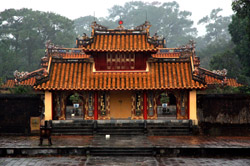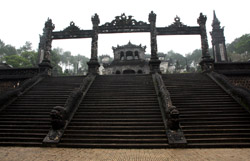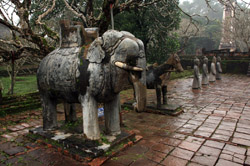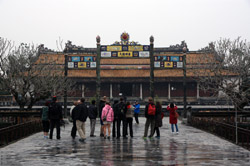| | | | |

Hue was the Vietnamese royal capital during the Nguyen Dynasty from 1802-1945, witnessing the coming and going of 13 emperors. The capital was moved here from Hanoi to unite the northern and southern sections of the country. The Nguyens were conservative and did not trust Western powers but ultimately had to bow to the French, becoming puppet emperors.
However, it was devastated by the French and American wars. Luckily, what has survived has been recognized and gained UNESCO World Heritage status in 1993.
Hue is easily accessible from Hanoi by a short 1-hour flight. With only a full day to explore, I opted to join a local tour to save the hassle of planning and hiring a driver.
|

|
Minh Mang's Tomb
Minh Mang ruled from 1820-1841. His tomb was patterned after the Ming tombs in Beijing and looks like a palace with pavilions, courtyards, and gardens.
|

|
Khai Dinh's Tomb
Khai Dinh ruled from 1916 until 1925 and his tomb spreads along the hillside. Completed in 1931 with both Western and European architectural styles, the predominant use of black concrete adds to a mysterious Gothic atmosphere. Incredible mosaics adorne the interiors.
|

|
Tu Duc's Tomb
Tu Duc ruled from 1848 until 1883, and designed this tomb not just as a final resting place, but also a place to enjoy before his death. The extravagance was so great and the construction was so coastly that a coup took place in 1866 to stop him.
|

|
Citadel
Built between 1804 and 1833, the Citadel's thick walls and huge moat protect the Imperial Enclosure and Purple Forbidden City. However, what we see today is nowhere as grand as the original, as the French and Americans bombed and destroyed a lot of buildings in more recent times.
|

